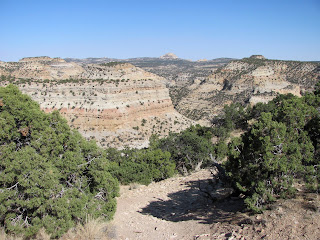 Great Basin National Park, created in 1986, is on the Utah-Nevada border along US 50. Lehman Cave, within the park, became a National Monument in 1922. There are multiple caves within the park. Our guide, a seasonal ranger who retired from the California Parks System, and had always loved these caves and who now lives in Bend, led a fascinating tour of this amazing cave. It isn't very large (2 miles total), but its features are absolutely amazing. The cave was "discovered" by Absalom Lehman in 1885 and he quickly began to charge people $1 to tour the cavern. It is a live cave.
Great Basin National Park, created in 1986, is on the Utah-Nevada border along US 50. Lehman Cave, within the park, became a National Monument in 1922. There are multiple caves within the park. Our guide, a seasonal ranger who retired from the California Parks System, and had always loved these caves and who now lives in Bend, led a fascinating tour of this amazing cave. It isn't very large (2 miles total), but its features are absolutely amazing. The cave was "discovered" by Absalom Lehman in 1885 and he quickly began to charge people $1 to tour the cavern. It is a live cave.
 Lehman Cave is famous for its speleothems, particularly its shields. Speleothems are the general term for stalactites, stalagmites, columns, draperies, flowstone, soda straws, cave bacon, shields and helicites. These structures, pictured to the left are thin growths that go in all sorts of directions because the water is oozing out so slowly that they don't form just straight down or up. The grey is shadow on the wall. They look a lot like coral growths.
Lehman Cave is famous for its speleothems, particularly its shields. Speleothems are the general term for stalactites, stalagmites, columns, draperies, flowstone, soda straws, cave bacon, shields and helicites. These structures, pictured to the left are thin growths that go in all sorts of directions because the water is oozing out so slowly that they don't form just straight down or up. The grey is shadow on the wall. They look a lot like coral growths. The most famous things in Lehman Cave are the discs. They occur in all sorts of positions and are created when water is ejected under pressure. There are always two discs that grow at the same rate, separated by a very thin crack where the water comes out. The water that manages to get out of the disc will create draperies, popcorn or other growths on the outside of the discs. At times one of the discs will fall off the ceiling. No one knows why Lehman Cave has so many discs.

More amazing pictures.

 Can you find all the discs?
Can you find all the discs?
 The most famous discs in the cave. They are called the parachute, but our guide said a child had described them as an elephant stepping on a piece of bubblegum.
The most famous discs in the cave. They are called the parachute, but our guide said a child had described them as an elephant stepping on a piece of bubblegum.






Thursday morning we woke up very early to drive up the road to Wheeler Peak to walk to the bristlecone pine forest and to avoid the wind. On the way we passed through different vegetation levels, including juniper, pinon pine, Douglas Fir, curly leaf mahogony, Lehman Pine, spruce, etc. We also passed the Osceola Ditch, an 18-mile long flume to divert water from Lehman Creek on the east side of the park to the mines of Osceola on the west side where they engaged in placer mining. The tiny glacier on Wheeler Peak is the southernmost glacier in North America and consists mainly of ice frozen in the rock debris, which when it melts lubricates the rocks which move like a glacier.
We hiked to the bristlecone pine forest at timberline. On the trail we met a BYU biologist who was studying flies during a bioblitz organized by the park over three days. The ranges in the basin and range area are like islands and species remain and develop in isolated islands because they cannot cross the desert. It is for this reason that there are no bears in Great Basin N.P.
The Pinnacle in the distance.
Bristlecone Pines are the oldest living creatures on the planet. They regularly live more than 3,000 years and survive by only keeping small portions of the tree alive. In this photo there are two strips of bark that are feeding those few branches that have bristles. The wood is extremely dense and resinous and is polished by the wind and the snow. Adversity seems to make them thrive and their needles can last more than 40 years.
This bristlecone pine has been dated by core samples at more than 3,200 years old. They are truly majestic things.
We headed east around 10:30 a.m. across Utah 21 through completely desolate territory until we hit Beaver on I-15. From there we took I-70 to Green River, where we camped for the night. This is a view from a roadside overlook on I-70 into the red rock canyon areas in southeastern Utah.

Great photos! Thanks for keeping us up to date on your travels.
ReplyDelete